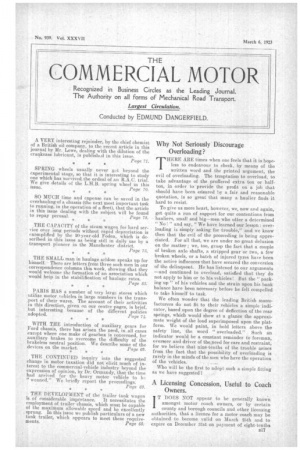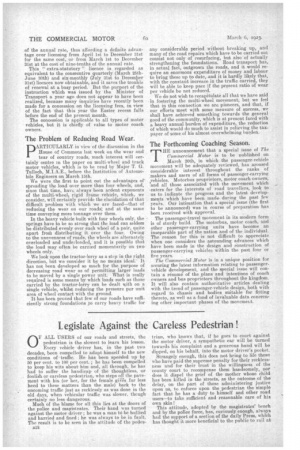Why Not Seriously Discourage . Overloading?
Page 1

Page 2

If you've noticed an error in this article please click here to report it so we can fix it.
THP:RE ARE times when one feels that it is hopeless to endeavour to check, by means of the written word and the printed argument, the evil of overloading. The temptation to overload, to take advantage of the proffered extra ton or halfton, in order to provide the profit on a job that should have been ensured by a fair and reasonable quotation, is so great that many a haulier finds it hard to resist.
To give as more heart, however, we, now and again, get quite a run of su,pport for our contentions from hauliere, small and big—men who utter a determined "No " and say, "We have learned our lesson: overloading is simply asking for trouble," and we know then that the evil of the proceeding is being appreciated. For all that, we are under no great delusion on the matter ; we, too, grasp the fact that a couple of broken axle shafts, a stripped gear or two, a few broken wheels, or a batch of injured tyres have been the active influences that have secured the conversion of the delinquent. He has listened to our arguments —and continued to overload, satisfied that they do not apply to him or to his vehicles! But the " packing up " of his vehicles and the strain upon his bank balance have been necessary before he felt compelled to take himself to task.
We often wonder that the leading British manufacturers do not fit to their vehicles a simple indicator, based upon the degree of deflection of the rear springs, which would show at a glance the approximate weight of the load superimposed upon the platform. We would paint, in bold letters above the safety line, the word " overloaded." Such an indicator would be a constant reminder to foreman, overseer and driver of theneed for care and restraint, for we believe that nine-tenths of the trouble arises from the fact that the possibility of overloading is rarely in the minds of the men who have the operation of the vehicles.
Who will be the first. to adopt such a simple fitting as we have suggested?
A Licensing Concession, Useful to Coach Owners. .
IT DOES NOT appear to be generally known amongst motor coach owners, or by certain county and borough councils and other licensing authorities, that a licence for a motor coach may be obtained to become valid on March 25th and to expire on December 31st on payment of eight-tenths
of the annual rate, thus affording a definite advantage over licensing from April 1st to December 31st for the same cost, or from March 1st to December 31st at the cost of nine-tenths of the annual rate.
This " extra-statutory " licence is regarded as equivalent to the consecutive quarterly (March 25thJune 30th) and six-monthly (July 31st to December 31st) licences now obtainable, and it saves the trouble of renewal at a busy period. But the purport of the instruction which was issued by the Minister of Transport a year ago does not appear to have been realized, because many inquiries have recently been made for a concession on the licensing fees, in view of the fact that this year the Easter recess falls before the end of the present month. The concession is applicable to all types of motor vehicles, but it is chiefly of value to motor coach owners.
The Problem of Reducing Road Wear.
pARTIOULARLY in view of the discussion in the House of Commons last week on the wear and tear of country roads, much interest will eerthinly centre in the paper on multi-wheel and track motor vehicles, which is to be read by Major T. G. Tulloch, M.I.A.E., before the Institution of Automobile Engineers on March 15th. We were the first to point out the advantages of spreading the load over more than four wheels, and, since that time, have always been ardent exponents of the multi-wheel, rigid frame vehicle, which, we consider, will certainly provide the elucidation of that difficult problem with which we are faced—that of reducing the wear on our road K and at the same time conveying more tonnage over them.
In the heavy vehicle built with four wheels only, the springs have to be so strong that the load can seldom be distributed evenly over each wheel of a pair, quite apart froth distributing it over the four. Owing to the unevenness of roads, the wheels are alternately overloaded and underlonded, and it is possible that the load may often be carried momentarily on two wheels only.
We look upon the tractor-lorry as a step in the right direction, but we consider it by no means ideal: It has not been developed so much for the purpose of decreasing road wear as of permitting larger loads to be moved by a single power unit. What is really required is some means by which loads such as those carried by the tractor-lorry can be dealt with on a single vehicle, whilst reducing the pressure per unit area of wheel contact with the ground. It has been proved that. few of our roads have sufficiently strong foundations to carry heavy traffic for any considerable period without breaking up, and many of the road repairs which have to be carried out consist not only of resurfacing, but also of actually strengthening the foundations. Road transport has, in actual fact, outgrown the roads, and it would require an enormous expenditure of money and labour to bring these up to date, and it is hardly likely that, with the constant increase in the traffic carried, they will be able to keep pace if the present ratio of wear per vehicle be not reduced.
We do not wish to recapitulate all that we have said • in fostering the multi-wheel movement, but we feel that in this connection we are pioneers, and that, if our efforts meet with some measure of success, we shall have achieved something towards the general good of the community, which is at present faced with a heavy annual burden of expenditure, the reduction of which would do much to assist in relieving the taxpayer of some of his almost overwhelming burden.
The Forthcoming Coaching Season:
THE announcement that a special issue of The Commercial Motor is to be nublished on March 20th, in which the passenger-vehicle movement will be adequately reviewed, has aroused considerable interest throughout the ranksof makers and users of all forms of passenger-carrying
' ,vehicles. Motorbus proprietors, motor coach owners, and all those associated with the movement which 'eaters for the interests of road travellers, look to us to indicate the progress and the latest developments which have been made during the past few yeais. Our intimation that a special issue (the first to be announced) was in course of preparation has been received with approval.
The passenger-travel movement in its modern form is of sturdy build. The motorbus, motor coach, and other passenger-carrying units have become an inseparable part of the nation and of the individual. The reason for this is not difficult to appreciate when one considers the astounding advances which have been made in the design and construction of passenger-carrying vehicles within the past four or five years.
The Commercial Motor is in a unique position for securing the latest information relating to passengervehicle development, and the special issue will contain a resum4 of the plans and intentions of coach owners and bus proprietors throughout the kingdom. It will also contain authoritative articles dealing with the trend of passenger-vehicle design, both with regard to chassis and bodies. suitable for fitting thereto, as well as a fund of invaluable data coneernmg other important phases of the movemeat.




























